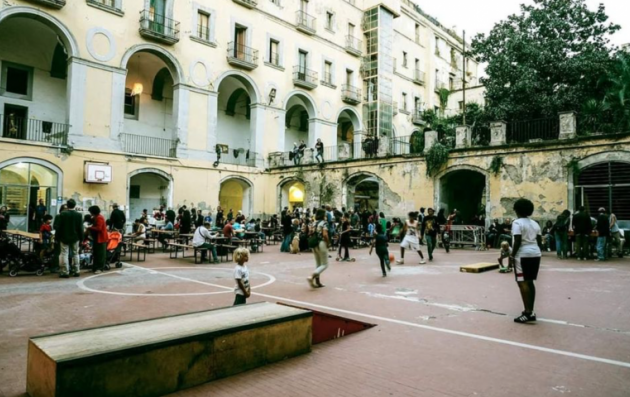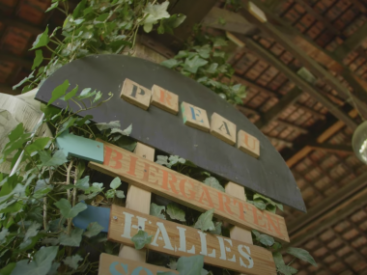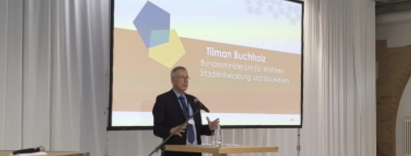-
-
Eesti
-
Deutschland
-
Česká republika
-
Arts and culture driving climate activism
ItalyMantovaYou can act for climate in a different way than you thought of
Copy linkFacebookXLinkedInEmail 48 000
48 000Summary
Building on the experience of Manchester’s Good Practice, Mantova has established ARC3A a new group for arts and culture sector collaboration on climate working closely with the city, designed and implemented climate-themed cultural activities to raise awareness about climate emergency and act to mitigate its effects and a range of sector support and policy measures to frame and drive sector action on climate
Solutions offered by the good practice
The small town of Mantova is a UNESCO World Heritage Site with fine architecture, which has a thriving creative scene and hosts hundreds of cultural events, including Italy’s most important literature festival. At the same time, addressing climate change is a key political priority for the city.
The municipality wanted to encourage more cross-departmental projects and integrated policy-making within the municipality. Having worked with a group of cultural stakeholders in a previous URBACT network, they discovered a strong interest in the links between art and culture and the environment, corresponding with the aims of C-CHANGE.
The cross-sectoral approach sparked a wealth of ideas and actions to reduce CO2 emissions, including small-scale activities - from reusable cups to bio-gas buses - at cultural events. The group also directly contributed to a new ‘plastic-free’ city strategy, environmental criteria in the city’s UNESCO management plan, and green public procurement processes for cultural events. Meanwhile, inspired by Manchester, small groups of stakeholders delivered carbon literacy training to their own communities.
Sustainable and integrated urban approach
The focus of the practice is the adaptation, if not mitigation, to climate change with the inclusion of the Art sector: art as a means and as an end. As such, it covers many areas of the work of municipalities, from social to economy, via heritage and education.
The work of the ULG (see below) has also ensure active cross-departmental approach within the administration.
Participatory approach
Environmental experts joined city hall staff and councillors involved in environmental policy, cultural events, venues and heritage in Mantova’s new URBACT Local Group (ULG) - a twist on the MAST model. They conducted a survey on environmental practice in local cultural venues and provided support such as training on sustainable events and an online tool to track audience travel impacts.
Whilst encouraging the local group to be independent, the municipality took on two roles: as sector ambassadors, pushing for sustainable solutions for cultural events and venues; and as fundraisers, securing over EUR 50 000 for additional C-CHANGE activities in the first year.
What difference has it made
Mantua enjoyed a C-CHANGE season of COVID-adapted events in summer 2020, including: children’s workshops; an installation on greenhouse gas emissions; a photography exhibition; an amateur photography competition; and children’s radio programmes. These events also reduced their own environmental impact, for example Festival Letteratura rethought the food it serves to its volunteers, and Woodstock MusicAcustica reduced waste and energy use, even changing its name to the C-Change Carbon Free Acoustic Music Festival.
Transferring the practice
Mantova enjoyed a C-CHANGE season of COVID-adapted events in summer 2020, including: children’s workshops; an installation on greenhouse gas emissions; a photography exhibition; an amateur photography competition; and children’s radio programmes. These events also reduced their own environmental impact, for example Festivalletteratura rethought the food it serves to its volunteers, and Woodstock MusicAcustica reduced waste and energy use, even changing its name to the C-Change Carbon Free Acoustic Music Festival.
An “inspirational” trip to Manchester introduced Mantova to members of MAST. They discovered examples of climate awareness raising, from a live energy display in a studio lobby, to sustainable food-sourcing on menus, and Carbon Literacy certificates.
Already looking beyond C-Change, the URBACT Local Group took on a new identity as ARC3A in summer 2020. ARC3A’s journey as a unifying force for supporting the crucial role the arts and culture sector has for improving climate resilience has only just begun.
In addition, Mantova is now set to transfer its adaptation of the C-CHANGE Good Practice to up to seven more Italian cities, thanks to the 2021-2022 URBACT National Practice Transfer Initiative.
-
Civic eState
ItalyNaplesCommunity management of common goods through Civic Uses

- Social cohesion
Copy linkFacebookXLinkedInEmail940 126Summary
Since 2015 the city of Naples has adopted the "Urban Civic Use Regula-tion" as a policy instrument allowing local communities to manage public assets as common goods. Starting from the pilot project established with the Ex Asilo Filangieri in 2012, more spaces in the city have been interest-ed by this innovative governance model enhancing local communities to use free and shared spaces, resources, knowledge and skills and improv-ing the engagement of citizens in the self-management of common re-sources. Through the participation to the URBACT transfer network Civic eState the City of Naples invested in developing networking among the different experiences self-managing Urban Commons in the city, supported their communication capacity, improved know-how and guidelines for the self-recovery of the buildings and community empowerment and fund raising strategies.
The solutions offered by the good practice
By revisiting the outmoded institution of civic use, the good practice of Napoli aims at making spontaneous bottom-up initiatives recognisable and institutionalised, ensuring the autonomy of both parties involved, the proactive citizens and the institutions. The first asset to be recognised as a commons, and therefore proposed as a good practice, is the Ex-Asilo Filangeri, a building that by resolution n.400 (2012) was already identified by the city of Naples as a “place with a complex use in the cultural field, and whose spaces are used to experiment in participative democracy”. At that time, it had been occupied by a group of art and culture professionals protesting against abandonment of the newly restored premises. With the following decision, n.893/2015, the city of Naples recognised the “Urban Civic Use Regulation” of the good, a declaration produced in an autonomous way by the community that benefits from the good, and that puts self-management as the main principle of its administration. Thanks to the good practice's governance model, more than 250 projects came to life, breaking down the production costs by using free and shared spaces, resources, knowledge and skills. During the last decade, the City of Naples has been experimenting with this new governance model to get back in use abandoned or underused buildings subtracted from the life of the city. Conflictual actions of occupation and bottom-up rule-creation were turned into an opportunity.
By acknowledging this regulation, the public administration assumes the burden of ensuring the usability of the place, while the right to make use of it is free and guaranteed to all citizens, accompanied by a participatory model that is founded on open assemblies and thematic roundtable talks.
The later resolution n.446/2016, recognised seven more public properties as “relevant civic spaces to be ascribed to the category of common goods”.Building on the sustainable and integrated urban approach
The integration is first and foremost assured through an ad-hoc municipal department, the “social enhancement of municipally owned spaces and common goods”, and with a political coordination in charge of the Urban Planning councillor. This department (technical level) and the above-mentioned councillor (political level) are in charge of promoting the col-laboration with other departments and councillors of the municipality, or other institutions.
Furthermore, the city waives completely the role of top-down manager and, with a horizontal subsidiarity mechanism, acts like a guarantor and takes its own burdens and responsibilities related to the operation of the good, while recognising the autonomy of the management system adopted by the users.
The horizontal integration lies also in the basic principles that are stated in the Urban Civic Use Regulation, produced autonomously by the community, and recognised by the Naples city council. The Civic Use of the Common goods is based on the principles of self-management, cooperation and mutualism, and tends to strengthen individual and collective responsibility. Empowerment is established by cooperation, in which each member of the community, whether guest or so-called inhabitant, contributes to the community's activities and management. Accordingly, every community of use has established his own Civic use declaration for the different goods.Based on participatory approach
Since March 2012 an open and inclusive management model is in place at the Ex -Asilo and has been progressively extended through an increasing number of experiences. Every week, an open meeting is convened (more than 190 since the projects' beginning), as well as several working groups for the implementation of activities (more than 830, with about 18,000 attendances). Besides ensuring transparency, this has established a strong bond between the inhabitants of the city, and narrowed the gap between artists, academics and citizens.
Main numbers since March 2012:- 18,000 people took part in the direct management of the Ex-Asilo through roundtable talks and public management assemblies;
- 150 public management assemblies for the self-government of the Ex-Asilo;
- 830 days of public working groups ("tables"), to deepen the projects and proposals. Topics are: "armeria" (visual arts), performing arts, self-government, library, cinema, "tavolo sociale", social, and urban gardening;
- 2,000 creatives including arts, culture and entertainment professionals, workers, artists, scholars, researchers, academics, associations, institu-tions, and citizens that have used Ex-Asilo spaces and resources, and/or organised activities.
What difference has it made
Through the civic eState Transfer Network the City of Napoli has been able to support the improvement of the practice with three key actions:
- The first identified objective was to improve the “Communication” of the urban commons of Naples, not only as a way to inform but also to involve actively other citizens in the network and also to help the “reproduction” of the network of the urban commons itself. The creation of the website CommonsNapoli managed by the network of Common goods in Napoli provides a web platform for the coordination of the different initiatives happening in this field that includes information about the activities developed in the seven self-managed spaces and documentation about the legal and policy tools and the observatory of urban commons goods.
- The second objective was to recognize institutionally the practices of co-design, self-construction and self-recovery of the urban commons, with the aim to strengthen the local capacity (both administrative and of the local communities) in finding solutions to the physical deterioration of the assets compatible with collective management and civic uses that are being experimented by the commoners. An ad hoc expert of a study has been commissioned a study that looks at innovations in the legal framework and experiences of self-recovery done in Italy in order to establish legal precedents and innovative procedures to apply the self-help construction procedure to publicly owned buildings destined to social use. The preliminary study has been preliminary to drafting of a set of guidelines to introduce the practice of self-help regeneration of common goods in the regulations of the City of Napoli.
- Ads a community empowerment action, a training on fund-raising was directed at the activists running the common goods in Napoli to support the financing of the regeneration and the activity of the seven initiatives. For this purpose, a very intense capacity building programme was offered to the activists, that included a workshop on community fundraising, whose beneficiaries were 46 activists belonging to 22 urban commons and other non-profit organizations; tutoring of the activists in the operational planning of 5 pilot fundraising campaigns for 5 urban commons, and a document elaborated by a senior fundraiser, who followed the whole training process, that contains specific guidelines for the fundraising of urban commons.
Transferring the practice
The participation to the Transfer network had the objective to share the urban co-governance principle in the use, management and ownership of urban commons and to discuss the use of local legal hacks such as the example of the urban civic uses successfully experimented in Naples. The mechanism proposed by the City of Naples, although routed in the Italian legal system, is characterized by a high degree of adaptability to other European urban contexts as it is based on largely shared ethic, legal and social values, already widespread in other countries. The civic eState Transfer Network included seven cities, with Napoli leading Amsterdam, Barcelona, Gdánsk, Ghent, Iaśi and Presov into the exchange of good practices. https://urbact.eu/civic-estate
-
Enriching the urban jungle with bees
PolandBydgoszczConnecting sites for bees freedom

- Climate action
Copy linkFacebookXLinkedInEmail350 000Summary
Bees are rich in terms of biodiversity protection, education development and touristic attraction. Transferring the practice of Lubljana, Bydgoszcz develop its own approach of connecting sites in the city that are bee-friendly and where apiaries can be visited. This is also included in a wider campaign for bee awareness and protection.
Solutions offered by the good practice
Bydgoszcz is the eighth largest city in Poland, part of the Bydgoszcz–Toruń metropolitan area, set on the on the Brda and Vistula rivers in northern Poland. It is an increasingly important economic centre, but the city is well known for its water, Art Nouveau buildings, and urban greenery – including the largest city park in Poland (830 ha).
The city has a dynamic approach to sustainable development as part of its efforts to improve the quality of life of the city’s inhabitants. Against this background, Bydgoszcz wanted to link its agricultural land and green spaces with ecological education and took a particular interest in Ljubljana’s approach to connecting sites in the city that are bee-friendly and where apiaries can be visited.
The City started to test and promote the quality of Bydgoszcz honey and used World Bee Day to implement a campaign on the ‘Urban reality of bees and people - let’s create a more bee-friendly world’, including photos at bus and tram stops, and messages on billboards. A local biologist produced a brochure on proper human behaviour towards bees and an exhibition.
But for ULG Coordinator, Justyna Olszewska, a highlight was local teachers getting enthusiastic about teaching children about bees. They developed a new educational programme called “With Bees Throughout the Year”, which gives children the opportunity to get to know about bees, beekeeping and related topics around health, plants and nature.
Sustainable and integrated urban approach
The approach undertaken by Bydgoszcz is fully aligned with the integrated approach of the Practice of Ljubljana that it transferred. Ecological practices related to beekeeping have been developed. The new EU project “Bez Lipy” introduces participatory approach to greenery development and a member of URBACT local group participates in the works.
The practice is also focusing on children and their education and attitude towards bees. This has also meant the development of professional skills and capacity to raise their awareness and develop bee-related activities as well as the enlargement of the network of urban beekeepers in the city. The city also promotes new (touristic) products and services related to beekeeping such as educational workshops run by Dawid Kilon, a biologist, guide and draftsman and bee-keeping workshops run at WSG University of Economy in Bydgoszcz.
Participatory approach
Bydgoszcz municipality formed an URBACT Local Group (ULG) mixing around 30 members - beekeepers, teachers, entrepreneurs, researchers, local tour guides and interested individuals. The group identified 16 places in the city with apiaries and melliferous potential to appear on their own Bee Path map of 16 stops – from a roof on the university, through Shopping Mall with beehives, pollinator houses in city parks, sensory garden at school, Bydgoszcz Soap Works to the botanical garden.
What difference has it made
In 2018 the City of Bydgoszcz lifted the ban on beekeeping in the city centre. Within the project we have managed to get to know beekeepers and educators who are ready to share their knowledge – in the very 2021 there are new beehives in the city centre: in May an apiary was installed by Mateusz Andryszak in Ostromecko Park and Palace Ensemble, and in June another one was installed in the Biziel University Hospital (Mateusz guided the endeavour). There are more and more bees initiatives application within the city grants and Bydgoszcz Citizens’ Participatory Budget, e.g. in 2022 there will be a municipal beehive installed and a bee-themed playground. Bydgoszcz is also starting the promotion of the Bee Education Programme in schools and we celebrate World Bee Day by installing the exhibition on bees that is accessible and offered to download and use as an open source and to be installed in any other city that wishes to educate about bees.
Transferring the practice
Visiting Ljubljana in April 2019 - together with stakeholders of BeePathNet’s other partner cities - members of Bydgoszcz’s ULG were truly inspired by how they too could create their own story around bees, linking to history, architecture and natural values.
The city hopes to install the popular bee educational programme across the whole education sector, from kindergarten up. There are also plans that Ania Izdebska with the local Tourist Office will create a ‘Bee Quest Game’ that will complement the town’s existing game for visitors.
Finally, the city also plans to explore further business opportunities and promotion, to take advantage of the growing interest in the project - including in other towns in the region.
Emailn.majewska@um.bydgoszcz.pl -
-
-







